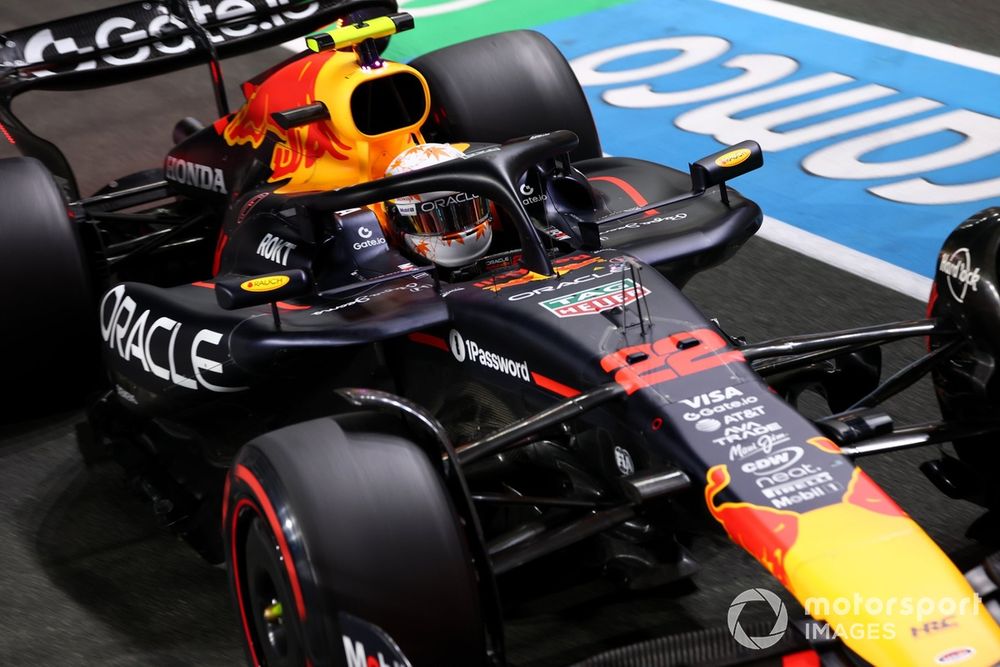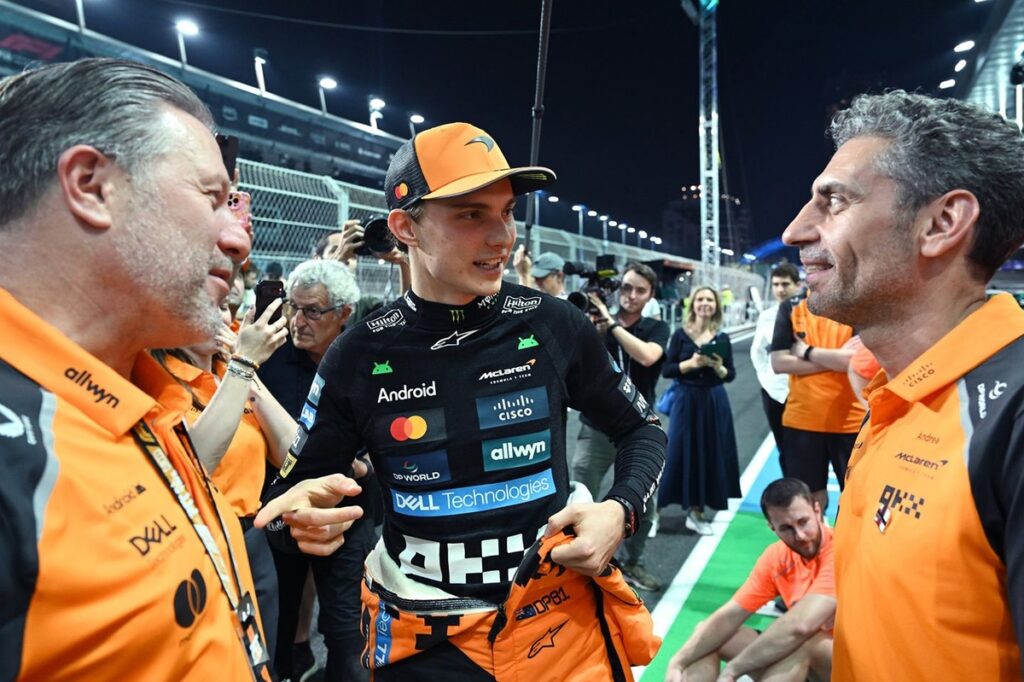After a brutal stretch of five races in six weeks, teams have been able to take stock and regroup for the second sprint weekend of the year at the Miami Autodrome. Here are the key storylines to look out for.
Can Norris regain momentum at the site of his maiden win?
Over its first three editions the race around the Miami Dolphins’ Hard Rock Stadium has hardly grown into a classic given its lacklustre on-track spectacle. The event has been more significant for off-track reasons as F1 aims to continue strengthening its US footprint.
But last year it did see history being made, with Lando Norris taking his maiden F1 victory for McLaren, heralding the start of a new era for the team as a big upgrade package transformed it into a title winning juggernaut once again.
McLaren started the 2025 season where it left off, taking four wins out of five, and it arguably should also have kept Max Verstappen from winning in Japan. But as Norris struggles to adapt to a vastly different car, team-mate Oscar Piastri is threatening to steal his thunder as McLaren’s biggest title protagonist, winning three races to Norris’ one win in Melbourne.
With 19 races to go – a full season not all that long ago – Piastri’s 10-point lead means nothing. What is significant is whether the young Australian can go on a bit of a run, and whether Norris can find his mojo and deliver cleaner weekends in the MCL39. Norris looked more comfortable in Saudi Arabia than he did in Bahrain, despite his costly qualifying crash, but he and the team need more steps to get him firing on all cylinders.
Lando Norris scored his breakthrough win in Miami last year
Photo by: Erik Junius
Is Miami a Red Bull friendly circuit?
F1 2025’s biggest enigma so far is Red Bull’s form. The squad was absolutely nowhere in Bahrain while Verstappen followed up his Suzuka heroics with more race winning form in Saudi Arabia, thwarted by a first-lap overtake from Piastri – and a resulting five-second time penalty for going off track to keep the McLaren driver behind.
Some clear trends have emerged over the first five weekends. McLaren has the quickest car, but it can really blow the competition away on hot and abrasive circuits where its superior management of the rear tyres is handsomely rewarded. When races feature low degradation and an easy one-stop, McLaren can’t flex its muscle that much, and Red Bull’s intrinsic pace makes it a capable challenger in the hands of Verstappen, as long as the team manages to keep its car balance in a reasonable window.
Significant Red Bull upgrades will follow in Imola, so for now it will have to keep counting on the execution of its trackside team and Verstappen’s brilliance. Miami is an interesting one in that respect. Pirelli is bringing the same range of softer tyre compounds from Jeddah – C3, C4 and C5. Coupled with the Miami heat, thermal degradation and overheating are going to be an issue.
If rear overheating on the softest C5 compound is going to be a factor over one lap, then expect McLaren to have a handsome advantage in qualifying. But the Miami Grand Prix is traditionally also a one-stop race, so degradation on the race compounds tends to be under control. Pirelli hopes moving towards a softer compound may force teams into two pitstops, but because overtaking is difficult in Miami teams will want to avoid an extra pitstop and keep track position if at all possible.

Yuki Tsunoda, Red Bull Racing
Photo by: Sam Bloxham / Motorsport Images
Mercedes vs Ferrari, Lewis Hamilton vs himself
Moving to softer compounds didn’t work out for Mercedes in Jeddah, where it had particularly poor race pace which didn’t reflect its strong start to the season thus far. The team says it has taken a lot of lessons from Saudi Arabia’s off-kilter race that it can apply to Miami, which will feature the same tyre compounds and temperatures.
While Andrea Kimi Antonelli is still learning the ropes and alternating impressive performances with more messy weekends, team leader George Russell is in the form of his life, with his form underpinning the team’s best start to the year in the fraught ground-effect era.
Ferrari has also been something of an enigma, looking promising in winter testing only to fall flat ever since, other than a shock Hamilton win in the China sprint and Leclerc’s first podium of the season in Jeddah. As with Red Bull, Ferrari’s first major upgrade push will have to wait for Imola and Barcelona, where the aim will be to add downforce to the SF-25.
In the meantime, Leclerc and especially Hamilton will have to make do with what they have. Hamilton has not had an awfully good time with these ground-effect cars since 2022, but he has been truly in the doldrums over recent races aboard the Ferrari. A lack of rear-end stability has hugely dented his confidence in the car, and Jeddah showed few signs of an imminent answer. Those upgrades can’t come soon enough.
Charles Leclerc, Ferrari; Andrea Kimi Antonelli, Mercedes; Lewis Hamilton, Ferrari
Photo by: Sam Bloxham / Motorsport Images
Who is edging ahead in the midfield?
Williams is leading the midfield battle in fifth thanks to both drivers scoring in Jeddah, but the team has already admitted it has largely turned off the development tap and is fully focused on next year. That makes its five-point lead over Haas even more precarious than it seems, so Alex Albon and Carlos Sainz will have to capitalise on these early races to defend and even build a lead.
Fortunately for Williams, none of its direct rivals have been consistently convincing and have instead taken points off each other. Haas has capitalised on its opportunities in brilliant fashion to hold sixth with 20 points, while the likes of Alpine and Racing Bulls appear to have more potential than their results have shown, as evidenced by Pierre Gasly’s excellent seventh place in Bahrain and Isack Hadjar’s heroics in Japan.
Isack Hadjar, Racing Bulls
Photo by: Peter Fox – Getty Images
Sprint format returns
Miami is also the second of the year’s six sprint weekends, meaning teams will have less margin for error. A reminder of the new sprint weekend format: the weekend will feature just a single practice session on Friday before going straight into sprint qualifying. After Saturday morning’s 19-lap sprint race, the cards are reshuffled as teams are allowed to make further set-up changes into grand prix qualifying on Saturday afternoon.
That set-up change window is more forgiving than under the old format, and teams will have more reliable long run data from Saturday morning’s sprint to make decisions on ride heights and other parameters. But it does mean that teams and drivers who have a slow start to the weekend or miss FP1 running will be punished. A surprise sprint winner is not out of the question, as seen in Shanghai when Hamilton took a victory which now feels a very long time ago.
Lewis Hamilton after winning the Shanghai sprint
Photo by: Mario Renzi – Formula 1 – Getty Images
In this article
Be the first to know and subscribe for real-time news email updates on these topics
Subscribe to news alerts
Read the full article here

